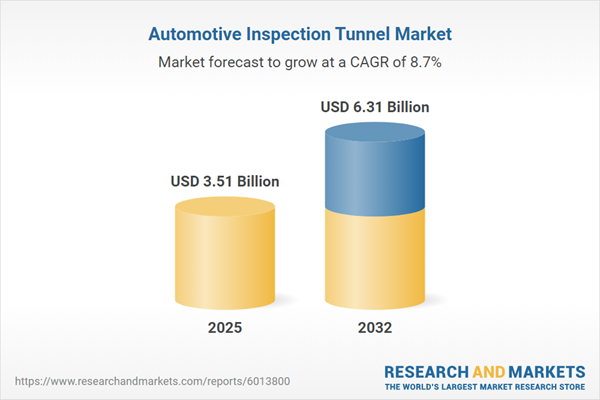Speak directly to the analyst to clarify any post sales queries you may have.
The automotive inspection tunnel market is undergoing significant transformation, as organizations strive for operational efficiency, seamless compliance, and scalable solutions amid evolving fleet compositions. Senior decision-makers now prioritize advanced automation and predictive technologies for resilience and ongoing regulatory alignment.
Market Snapshot: Automotive Inspection Tunnel Market Growth
The automotive inspection tunnel market reached a valuation of USD 3.23 billion in 2024 and is projected to attain USD 3.51 billion in 2025, exhibiting an 8.72% compound annual growth rate (CAGR). Automated inspection systems drive this growth, as organizations adopt high-capacity, reliable solutions aligned with stringent safety and emissions standards. Leading companies are accelerating innovation to reduce manual labor, promote accuracy in inspections, and ensure consistent compliance. Increasing market adoption of automation supports initiatives in risk management and enhances operational longevity, positioning the sector favorably for sustained expansion.
Scope & Segmentation: Comprehensive Market Coverage
- Deployment Model: Fixed installations are engineered for locations demanding high throughput, while mobile inspection tunnels provide flexibility for fleets requiring frequent relocation or adaptive scheduling.
- Tunnel Configuration: Multi-lane tunnel solutions are favored for fleet processing efficiency; single-lane tunnels serve environments managing specialized or moderate vehicle volumes.
- Vehicle Type: Inspection tunnel systems accommodate diverse vehicle classes, including heavy-duty trucks, passenger cars, light vans, as well as electric and hybrid vehicles, aligning with mixed fleet demands.
- Automation Level: Options range from fully automated to semi-automatic and manual systems, allowing organizations to align inspection rigor and process control with internal compliance requirements.
- Functional Module: Core modules encompass brake system assessment, emissions measurement, lighting verification, and underbody inspection, supporting both regulatory adherence and predictive maintenance goals.
- Region: The Americas, Europe, Middle East and Africa, and Asia-Pacific each feature distinct regulatory frameworks and rates of technology adoption, making regional adaptability a critical factor for market competitiveness.
- Companies Profiled: Major providers include Applus+ Technologies, Robert Bosch GmbH, MAHA Maschinenbau Haldenwang GmbH & Co. KG, BAUR Prüf- und Messtechnik GmbH, Snap-on Incorporated, Hunter Engineering Company, John Bean Technologies Corporation, HELLA Gutmann Solutions GmbH, TEXA S.p.A., and Autel Intelligent Technology Corp., Ltd.
Key Takeaways: Strategic Insights for Senior Decision-Makers
- Integration of sensor networks and adoption of real-time analytics enhance inspection precision and strengthen compliance monitoring for improved risk mitigation.
- Mobile and modular tunnel solutions deliver agility in redeployment and support capacity scaling, empowering organizations to adapt infrastructure to shifting operational requirements.
- Broad system compatibility with electric, hybrid, and traditional vehicle types keeps fleet operators on pace with evolving environmental mandates and global sustainability drivers.
- Utilization of AI-powered imaging and predictive diagnostic analytics reduce maintenance disruptions and maximize vehicle uptime, increasing overall fleet productivity.
- Business growth in new regions is influenced by tailored investment strategies and cost management approaches that address regional compliance complexity and infrastructure diversity.
- Building strong supplier relationships streamlines technology integration, secures timely solution adoption, and sustains operational continuity in changing market conditions.
Tariff Impact on Supply Chains
Recent tariff changes impacting imported inspection tunnel components have encouraged a pivot to domestic sourcing and regional assembly. These shifts reinforce local supply chains and facilitate cost control, while modular tunnel designs help companies adjust capacity without compromising quality. Proactive inventory management and adaptable site planning also help maintain steady inspection operations despite external disruptions.
Methodology & Data Sources
This market analysis is based on executive interviews, thorough on-site assessments, and technical breakdowns of automotive inspection tunnel systems. Validation utilizes technical publications, patent datasets, and rigorous evaluation of regional regulations, delivering findings that are actionable for executive planning.
Why This Report Matters
- Guides capital planning, technology adoption, and operational improvements for maximum efficiency in the automotive inspection tunnel sector.
- Explains how evolving regulations, inspection innovations, and variable market forces intersect to inform organizational strategy.
- Enables leadership teams to optimize integration processes, strengthen supply chain performance, and implement precise cost control across multiple regions.
Conclusion
Maintaining a competitive edge in the automotive inspection tunnel market requires continual innovation and strategic agility. Forward-focused initiatives position organizations to address emerging operational shifts and compliance requirements confidently as the industry landscape advances.
Additional Product Information:
- Purchase of this report includes 1 year online access with quarterly updates.
- This report can be updated on request. Please contact our Customer Experience team using the Ask a Question widget on our website.
Table of Contents
3. Executive Summary
4. Market Overview
7. Cumulative Impact of Artificial Intelligence 2025
Companies Mentioned
The companies profiled in this Automotive Inspection Tunnel market report include:- Applus+ Technologies, S.A.
- Robert Bosch GmbH
- MAHA Maschinenbau Haldenwang GmbH & Co. KG
- BAUR Prüf- und Messtechnik GmbH
- Snap-on Incorporated
- Hunter Engineering Company
- John Bean Technologies Corporation
- HELLA Gutmann Solutions GmbH
- TEXA S.p.A.
- Autel Intelligent Technology Corp., Ltd.
Table Information
| Report Attribute | Details |
|---|---|
| No. of Pages | 196 |
| Published | November 2025 |
| Forecast Period | 2025 - 2032 |
| Estimated Market Value ( USD | $ 3.51 Billion |
| Forecasted Market Value ( USD | $ 6.31 Billion |
| Compound Annual Growth Rate | 8.7% |
| Regions Covered | Global |
| No. of Companies Mentioned | 11 |









